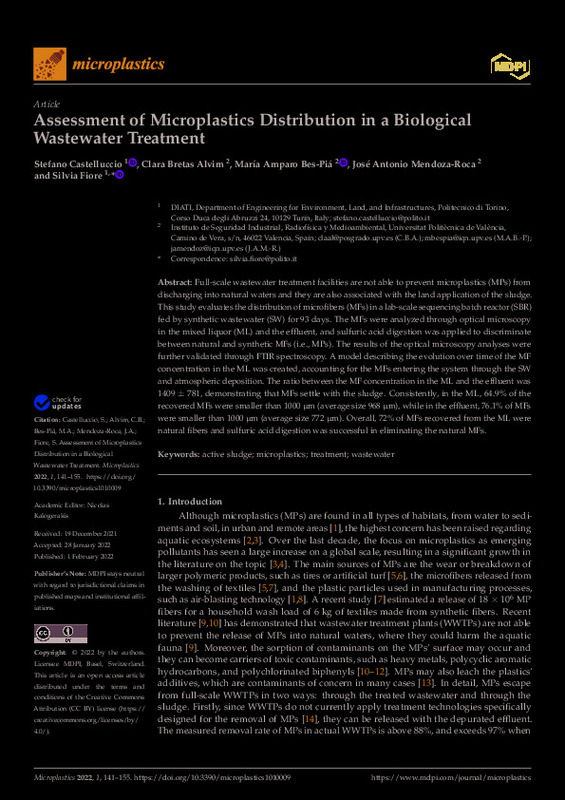JavaScript is disabled for your browser. Some features of this site may not work without it.
Buscar en RiuNet
Listar
Mi cuenta
Estadísticas
Ayuda RiuNet
Admin. UPV
Assessment of Microplastics Distribution in a Biological Wastewater Treatment
Mostrar el registro sencillo del ítem
Ficheros en el ítem
| dc.contributor.author | Castelluccio, Stefano
|
es_ES |
| dc.contributor.author | Alvim, Clara Bretas
|
es_ES |
| dc.contributor.author | Bes-Piá, M.A.
|
es_ES |
| dc.contributor.author | Mendoza Roca, José Antonio
|
es_ES |
| dc.contributor.author | Fiore, Silvia
|
es_ES |
| dc.date.accessioned | 2023-09-12T18:04:21Z | |
| dc.date.available | 2023-09-12T18:04:21Z | |
| dc.date.issued | 2022-02-01 | es_ES |
| dc.identifier.uri | http://hdl.handle.net/10251/196275 | |
| dc.description.abstract | [EN] Full-scale wastewater treatment facilities are not able to prevent microplastics (MPs) from discharging into natural waters and they are also associated with the land application of the sludge. This study evaluates the distribution of microfibers (MFs) in a lab-scale sequencing batch reactor (SBR) fed by synthetic wastewater (SW) for 93 days. The MFs were analyzed through optical microscopy in the mixed liquor (ML) and the effluent, and sulfuric acid digestion was applied to discriminate between natural and synthetic MFs (i.e., MPs). The results of the optical microscopy analyses were further validated through FTIR spectroscopy. A model describing the evolution over time of the MF concentration in the ML was created, accounting for the MFs entering the system through the SW and atmospheric deposition. The ratio between the MF concentration in the ML and the effluent was 1409 ± 781, demonstrating that MFs settle with the sludge. Consistently, in the ML, 64.9% of the recovered MFs were smaller than 1000 µm (average size 968 µm), while in the effluent, 76.1% of MFs were smaller than 1000 µm (average size 772 µm). Overall, 72% of MFs recovered from the ML were natural fibers and sulfuric acid digestion was successful in eliminating the natural MFs. | es_ES |
| dc.description.sponsorship | This research was funded by the Spanish Ministry of Science, Innovation and Universities (grant number: RTI2018-096916-B-I00). | es_ES |
| dc.language | Inglés | es_ES |
| dc.publisher | MDPI AG | es_ES |
| dc.relation.ispartof | Microplastics | es_ES |
| dc.rights | Reconocimiento (by) | es_ES |
| dc.subject | Active sludge | es_ES |
| dc.subject | Microplastics | es_ES |
| dc.subject | Treatment | es_ES |
| dc.subject | Wastewater | es_ES |
| dc.subject.classification | INGENIERIA QUIMICA | es_ES |
| dc.title | Assessment of Microplastics Distribution in a Biological Wastewater Treatment | es_ES |
| dc.type | Artículo | es_ES |
| dc.identifier.doi | 10.3390/microplastics1010009 | es_ES |
| dc.relation.projectID | info:eu-repo/grantAgreement/AEI/Plan Estatal de Investigación Científica y Técnica y de Innovación 2017-2020/RTI2018-096916-B-I00/ES/ELIMINACION E INFLUENCIA DE LOS MICROPLASTICOS Y NANOPLASTICOS EN BIORREACTORES DE MEMBRANA Y EN PROCESOS DE REGENERACION DE AGUAS RESIDUALES CON MEMBRANAS/ | es_ES |
| dc.rights.accessRights | Abierto | es_ES |
| dc.contributor.affiliation | Universitat Politècnica de València. Escuela Técnica Superior de Ingenieros Industriales - Escola Tècnica Superior d'Enginyers Industrials | es_ES |
| dc.description.bibliographicCitation | Castelluccio, S.; Alvim, CB.; Bes-Piá, M.; Mendoza Roca, JA.; Fiore, S. (2022). Assessment of Microplastics Distribution in a Biological Wastewater Treatment. Microplastics. 1(1):141-155. https://doi.org/10.3390/microplastics1010009 | es_ES |
| dc.description.accrualMethod | S | es_ES |
| dc.relation.publisherversion | https://doi.org/10.3390/microplastics1010009 | es_ES |
| dc.description.upvformatpinicio | 141 | es_ES |
| dc.description.upvformatpfin | 155 | es_ES |
| dc.type.version | info:eu-repo/semantics/publishedVersion | es_ES |
| dc.description.volume | 1 | es_ES |
| dc.description.issue | 1 | es_ES |
| dc.identifier.eissn | 2673-8929 | es_ES |
| dc.relation.pasarela | S\462676 | es_ES |
| dc.contributor.funder | AGENCIA ESTATAL DE INVESTIGACION | es_ES |
| dc.subject.ods | 06.- Garantizar la disponibilidad y la gestión sostenible del agua y el saneamiento para todos | es_ES |








